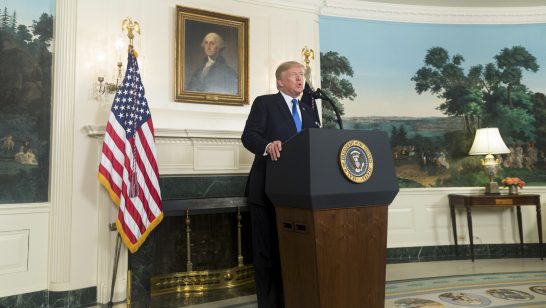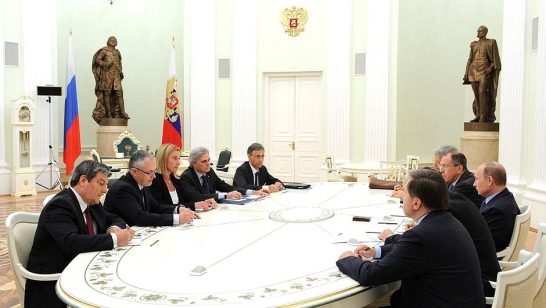
One of the few optimistic developments in global politics during the last months has been the final agreement on the Iran nuclear issue. In the United States, there is now sufficient Congressional support to secure its implementation, despite lingering Republican threats to undermine it with further sanctions legislation. The Iranian parliament has recently approved the deal and the Guardian Council confirmed that it is not in disagreement with Islam or the Constitution. So Iran is now also ready for implementation.
That the final agreement was reached within the mid-2015 timeframe was a surprise. A number of experts had forecasted a further process with long-lasting postponements, with the status of the Iranian nuclear program remaining in doubt. Opponents wanted to renegotiate and increase sanctions, and demanded complete dismantlement of Iran’s nuclear infrastructure.
The surprising success of the negotiations has given rise to a debate on whether the “P5+1 formula”—the negotiating partnership of the United States, Russia, the United Kingdom, France, China, plus Germany—could be useful to resolve other crises as well, notably in Syria and in Ukraine.
Before rushing to multiply the P5+1 or similar formats as a universal negotiating forum in global crises, we must understand what made this special construction so successful on Iran. What conditions were in place to achieve results? How were decades of animosity bridged in a deal which, while not perfect for either side, outlines a path forward, not only for nonproliferation, but for coercive diplomacy in general?
The P5+1 formula was activated in 2006, when the Iran nuclear issue was first referred to the Security Council. Until then, since 2003, negotiations had been carried out by the European E-3 group: Great Britain, France, and Germany. Once the Security Council became seized of the matter on Iran’s nuclear program, the rest of the Council’s permanent members, the P5, were the natural addition to the negotiators. Berlin remained on board, even though it wasn’t a member of the Council at that time. The US supported the idea of Germany remaining party to the negotiations, since it had its own useful diplomatic contacts with Iran.
Still, political will, not the choice of the negotiating forum, was the first precondition for success. It was not until Barack Obama took office that things started to move. Already in 2009, he reached out to the Iranians. After failing to receive a response, a “dual-track” approach—diplomacy plus sanctions—replaced the previous policy of favoring regime change. After the 2013 election of Hassan Rouhani, even better dynamics began to emerge: there was now political will and determination on both sides. That was the crucial point. Obama needed a foreign policy success; Rouhani needed tangible sanctions relief. The two presidents carried the deal through the pitfalls of uranium enrichment details and disagreements over inspections of military sites. Another value added was that amiable relations emerged between the two foreign ministers Kerry and Zarif in the process.
True, the P5+1 was a multilateral forum. Nevertheless, results were only achieved in bilateral negotiations between the two adversaries, the US and Iran, mediated by Oman. This was true of the interim deal agreed to in Geneva in November 2013 as well as in the case of the framework agreement and the final deal, agreed to in July 2015. Much to the distress of other P5+1 members—France, in particular—the United States kept them only marginally informed as the negotiations proceeded, and offered few opportunities for truly substantive input. This should not be interpreted as an assertion that the P5+1 formula was not essential for achieving the final result. On the contrary: that format provided a perfectly acceptable political umbrella for the Iranians. While the Americans saw the final negotiations as bilateral, the former Iranian negotiator, Sayeed Jalili, in a hearing before the Iranian parliamentary committee exploring the deal, defended it by asserting that: “we never negotiated with the Americans, we negotiated with the P5+1.”
The ways in which the P 5+1 formula operated can also teach us a lesson. Even if political will of the US and Iran was essential, the involvement of all five of the permanent Security Council members in the process ensured effective Security Council endorsement of the deal that eventually emerged. The permanent members need to have a stake in the deal if we want to make sure they do not act as spoilers later on. This does not mean that all Council members should participate in all negotiations; only that they should have the opportunity to do so. If they refuse participation, they would also, in a sense, disavow their right of veto.
Adding a “+1,”—or even a “+ several”—is also a good idea when the selected country is a party to the conflict or when it maintains good diplomatic relations with both adversaries and thus can suggest a compromise position on some controversial issues. That was the role of Germany in the Iranian case. In the case of Syria, the additional “+3” could be Iran, Saudi Arabia and Turkey. The Syrian negotiations convened in Vienna last week included the US, Russia and the EU as well as Saudi Arabia, Turkey and for the first time, Iran. This is the first time in decades that the US has sat down with Iran to discuss issues other than the Iran nuclear deal and the first time the two rivals, Saudi Arabia and Iran, have been at the same table discussing Syria. But why not include China, given the lessons learned from the P5+1 process, and China’s growing interests in the Middle East?
Clearly the conditions that made the P5+1 formulation a winning strategy in the Iran nuclear negotiations cannot be easily replicated to solve the Syrian crisis. But understanding better what made the nuclear negotiations so successful can help us shape effective diplomatic approaches to the Syrian problem, and other crises in the future.
The opinions articulated above represent the views of the author(s), and do not necessarily reflect the position of the European Leadership Network or any of its members. The ELN’s aim is to encourage debates that will help develop Europe’s capacity to address the pressing foreign, defence, and security policy challenges of our time.



